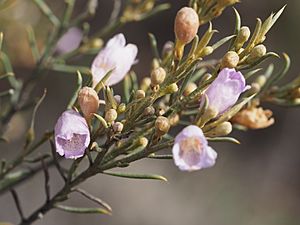Silver emubush facts for kids
Quick facts for kids Silver emubush |
|
|---|---|
 |
|
| Eremophila scoparia leaves and flowers | |
| Scientific classification | |
| Genus: |
Eremophila (plant)
|
| Species: |
scoparia
|
| Synonyms | |
|
|
The Silver Emubush (scientific name: Eremophila scoparia) is a beautiful flowering plant. It belongs to the figwort family and grows only in Australia. This plant looks like a broom with its thin, curved leaves. Its flowers can be deep lilac or white. You can find the Silver Emubush in many southern parts of Australia.
Contents
About the Silver Emubush
The Silver Emubush is a shrub that looks like a broom. It can grow to be about 1 to 3 meters (3 to 10 feet) tall. Its branches and leaves are covered with tiny, yellowish or silvery-grey scales. These scales make the plant look smooth.
The leaves are usually in pairs, one across from the other. They are thin and almost round, shaped like an "S" when you look at them from the side. Each leaf is about 4 to 25 millimeters (0.15 to 1 inch) long. They have a small hook at the end.
Flowers and Fruit
The flowers grow alone or in pairs where the leaves meet the stem. Each flower sits on a small stalk, about 2 to 6 millimeters long. This stalk has the same scaly covering as the leaves.
Each flower has five small, thin parts called sepals. These sepals are about 1.5 to 3.5 millimeters long. They are scaly on the outside but hairy on the inside. The petals of the flower are joined together at the bottom to form a tube. This tube is about 8 to 25 millimeters long.
The petal tube can be blue, lilac, pink, or white on the outside. Inside, it is white with yellow spots. The outside of the petals and their tips are covered with scaly hairs. The inside of the tips is smooth, except for some branched hairs near the edges. The inside of the tube is full of long, soft hairs. There are four stamens (the parts that make pollen) hidden inside the petal tube.
Silver Emubush flowers can bloom all year, but they mostly bloom from August to October. After flowering, the plant produces dry, woody fruits. These fruits are oval or cone-shaped and almost round. They are about 3.3 to 5 millimeters long and also have a scaly covering.
How it Got its Name
This plant was first officially described in 1810 by a botanist named Robert Brown. He called it Pholidia scoparia. Later, in 1860, another botanist named Mueller changed its name to Eremophila scoparia.
The word scoparia in its scientific name comes from Latin. It means 'broom-like', which describes how the plant looks.
The Silver Emubush is also known by other common names. These include broom bush, scotia bush, wax bush, and broom emu bush.
Where it Grows
The Silver Emubush grows in several parts of Australia. You can find it in Western Australia, South Australia, Victoria, and New South Wales.
In Western Australia, it grows in areas like Merredin and Echuca. It is found in many different types of soil. This plant is common in areas with mulga trees, mallee trees, and chenopod plants. Often, the Silver Emubush is the main shrub growing in these places.
Looking After the Plant
The Western Australian Government's Department of Parks and Wildlife says that the Silver Emubush is "not threatened." This means there are plenty of them in the wild.
Growing Silver Emubush
People like to grow this plant in gardens because of its broom-like shape and pretty lilac flowers. You can grow new plants from cuttings (small pieces of the plant). You can also graft it onto a Myoporum plant, which means joining a piece of the Silver Emubush to the roots of a Myoporum plant.
It grows best in soil that drains water well. It can grow in full sun or in partial shade. This plant is very tough! It can handle dry weather and even very cold frosts. You can trim it to keep its shape or to make an older plant look new again.
Images for kids



